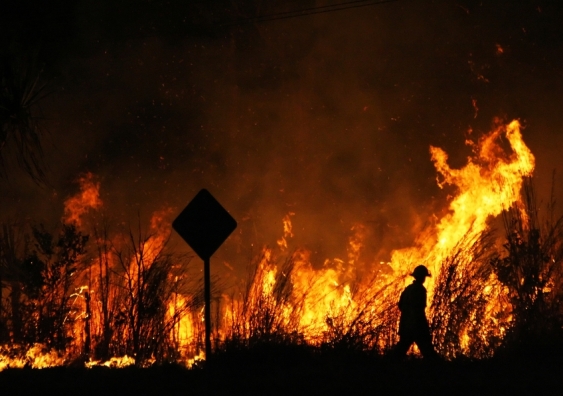Unveiling the Risks: Why Every Property Owner Needs a Bushfire Risk Assessment
Unveiling the Risks: Why Every Property Owner Needs a Bushfire Risk Assessment
Blog Article
Essential Tips for Bushfire Management to Make Sure Fire Defense

Understanding Bushfire Risk Degrees
Recognizing the varying levels of bushfire threat is vital for effective preparation and preparation in mitigating potential threats to lives and residential properties. Bushfire danger levels are usually categorized based upon aspects such as weather, fuel schedule, topography, and historical fire actions. By understanding these risk communities, people and degrees can proactively implement strategies to minimize susceptability and boost resilience when faced with possible bushfire occasions.
The initial degree of bushfire risk is reduced risk, where the likelihood of a bushfire happening and causing substantial harm is minimal. Risky degrees symbolize a substantial threat, with conditions helpful to quick fire spread and extreme fire habits.
Comprehending these bushfire danger levels makes it possible for stakeholders to customize their preparedness and reaction actions as necessary, guaranteeing a reliable and proactive method to bushfire management.
Creating a Defensible Room
Efficient bushfire management starts with developing a defensible space around residential or commercial properties to boost defense against possible fire hazards. A defensible area is a barrier zone that develops a barrier in between a framework and the surrounding combustible plants. This space functions as a crucial line of protection, providing firemans a safe location to operate and aiding to decrease the danger of a fire infecting the building.
When developing a defensible room, it is important to think about the layout of the home and the bordering landscape. Clearing up plants, especially highly combustible plants, within a certain span of the residential or commercial property can aid prevent the fast spread of fires. Furthermore, maintaining a well-irrigated zone around the building can further improve its defensibility.
Regular maintenance of the defensible area is important to ensure its efficiency. This includes cutting looming branches, clearing dead greenery, and maintaining the area without debris. By spending time and initiative right into creating and keeping a defensible area, homeowner can dramatically boost their chances of securing their homes and possessions during a bushfire.
Applying Fireproof Landscape Design
When developing landscapes to mitigate the threat of bushfires, incorporating fire-resistant components is crucial for improving property protection and lowering fire dangers. Select plants with high moisture web content, low oil content, and marginal dead vegetation to minimize the risk of fire spread.

Creating an Emergency Situation Evacuation Strategy
Developing a comprehensive emergency situation evacuation strategy is essential for ensuring the safety and security and well-being of people during prospective bushfire cases (BAL Report). A reliable discharge plan must detail clear treatments to adhere to in the occasion of a bushfire danger, consisting of marked discharge routes, setting up factors, and communication methods
To begin producing an emergency evacuation strategy, it is important to assess the particular dangers and susceptabilities of your location. Identify multiple emptying routes that result in risk-free locations far from the fire, taking into consideration elements such as terrain, road accessibility, and potential dangers. Establish communication channels to alert citizens of an upcoming discharge, making use of approaches such as alarms, text notifies, or door-to-door notifications.
Consistently testimonial and exercise the discharge strategy with all homeowners or area participants to make sure every person recognizes their functions and obligations. Conduct drills to check the effectiveness of the strategy and make any necessary modifications. By having a well-prepared emptying plan in location, you can enhance the possibilities of a orderly and safe discharge throughout a bushfire emergency situation.
Maintaining Fire Safety And Security Devices
After establishing an extensive emergency evacuation plan for bushfire cases, it is vital to prioritize the normal advice upkeep of fire safety and security equipment to guarantee optimum performance and readiness. Regular upkeep of fire safety equipment such as fire extinguishers, smoke detectors, smoke alarm, and sprinkler systems is important in protecting lives and residential property during a bushfire. Performing routine inspections, screening, and servicing of these tools by qualified professionals is vital to ensure they remain in working order when required.
Fire extinguishers must be checked regularly for pressure degrees, noticeable damages, and proper performance. Smoke alarm must have their batteries changed at least when a year and undertake monthly testing to guarantee they are functional. Smoke alarm and automatic sprinkler should be examined occasionally to confirm they are attached and working properly. Furthermore, it is vital to maintain fire safety equipment accessible, unobstructed, and clearly identified for simple recognition throughout an emergency situation. By vigilantly preserving fire security tools, people can boost their readiness and action capacities in the event of a bushfire.
Verdict
Finally, effective bushfire monitoring entails comprehending risk degrees, developing defensible areas, carrying out fire-resistant landscape design, creating evacuation plans, and preserving fire safety and security equipment. By following these crucial ideas, individuals can guarantee far better fire security and safety for their residential properties and neighborhoods. It is essential to focus on proactive measures to minimize the risks connected with bushfires and to be prepared for emergencies.
By understanding the subtleties of bushfire risk degrees, creating defensible rooms, implementing fireproof landscape design, producing thorough emptying plans, and ensuring the maintenance of fire safety and security devices, communities and individuals can considerably reinforce their durability versus the ravages of wildfires - BAL Assessment. These ideas are not only vital for protecting versus immediate fire dangers but likewise for fostering lasting fire protection methods that can make a significant difference in the face of intensifying bushfire threats
High-risk levels symbolize a significant danger, with problems conducive to rapid fire spread and extreme fire actions. Routine upkeep of fire security devices such as fire extinguishers, smoke detectors, fire alarm systems, and lawn sprinkler systems is crucial in securing lives and property during a bushfire.In conclusion, reliable bushfire management involves comprehending danger degrees, creating defensible rooms, executing fire-resistant landscaping, developing evacuation strategies, and keeping fire safety devices.
Report this page